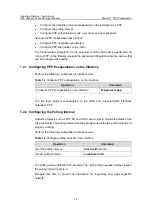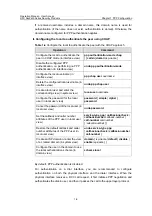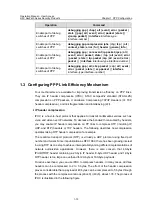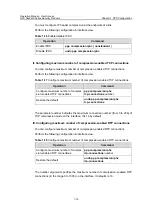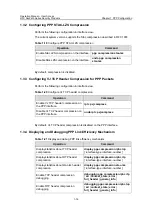
Operation Manual – User Access
H3C SecPath Series Security Products
Chapter 1 PPP Configuration
1-4
1.2.3 Configuring PPP Authentication Mode and Username and User
Password
The local and the peer support both CHAP and PAP authentication approaches
between them. The configuration procedures in both approaches will be described in
the following subsections. This chapter only discusses local authentication. For
information about the remote AAA authentication, refer to the Security module in this
manual.
I. Configuring the local to authenticate the peer using PAP
Table 1-3
Configure the local to authenticate the peer with the PAP approach
Operation
Command
Configure the local to authenticate the
peer in PAP mode (in interface view).
ppp authentication-mode
pap
[[
call-in
]
domain isp-name
]
Disable the configured PPP
authentication mode, i.e. performing no
PPP authentication (in interface view).
undo ppp authentication-mode
Create a local user and enter the
corresponding view (in system view)
local-user
username
Configure the password for the local
user (in local user view)
password
{
simple
|
cipher
}
password
Cancel the password of the local user (in
local user view)
undo password
Set the callback and caller number
attributes of the PPP user (in local user
view)
service-type ppp
[
callback-nocheck
|
callback-number callback-number
|
call-number call-number
[
:subcall-number
] ]
Restore the default callback and caller
number attributes of the PPP user (in
local user view)
undo service-type ppp
[
callback-nocheck
|
callback-number
|
call-number
]
Create an ISP domain or enter the view
of a created domain (in system view)
domain
{
isp-name
|
default
{
disable
|
enable isp-name
} }
Configure the user in the domain to use
the local authentication scheme (in
domain view)
scheme
local
By default, PPP authentication is disabled.
If you configure the
ppp authentication-mode
{
pap
|
chap
} command without
specifying a domain, the system-default domain applies by default, adopting local
authentication. The address pool configured in the domain must be used. If a domain is
specified, you must configure an address pool in the specified domain.





